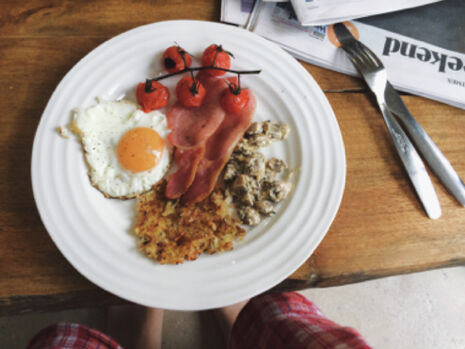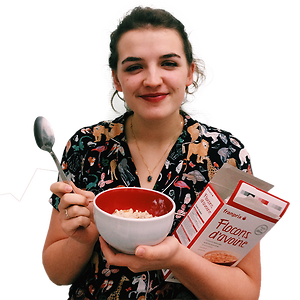
Cereal Offender: The Full(er) English Breakfast
Xanthe Fuller presents the definitive guide to the Full English

Right. We all knew this day would come. There’s only so much that I can dilly-dally about discussing cereals. It’s time that we get to the real meaty stuff: the Full English Breakfast. I have come up with the absolutely hilarious idea of integrating my name into this (see title), but this is not just for fun and games, it has a purpose. Today I shall go through the various elements of the Full English – from the staunch ingredients, to the niche – and decide once and for all what belongs on the perfect plate.
I expressed my fear about this being an entirely opinion-based article to my brother and he wisely said: “facts are out of fashion; opinions are in.” So, call me fickle, but I’m going to follow the latest trend.
Eggs – there are so many – almost too many – options. I’ll go through the typical five to find the Z-eggy Stardust among them.
Let’s start with the easy things – no soft-boiled eggs. They only shine when given prime position and a regiment of soldiers. To include them in a full English would be doing them a disservice. And hard-boiled eggs don’t even need to be considered. Sunny side up or over easy eggs (also known as fried, but that’s far less fun) both work well in a Full English context – the yolk isn’t so runny that it rules the plate and you get a splash of colour, which is always a welcome addition for the more aesthetically-conscious. Obviously, if they’re too slimy then they’re of no interest, but that’s a philosophy to apply to many things.
And what if you poach them? An excellent suggestion – poaching eggs leaves them soft and incredibly satisfying to stab open. Finally, with a subtlety of flavour and the fact that they bring a whole new texture to the table, scrambled eggs cannot and shall not be forgotten.
“The Full English should be the Berghain of the breakfast world, you can’t just let any riff-raff in”
Controversially, however, I’m going to say that I would not put them in the top two eggs for the Full English. Overwhelmed by the other tastes on the plate, you can barely discern their delicate buttery taste when combined with the saline tang of bacon or the sugary flood of beans. They would be perfect for a minimalist cooked breakfast – a Half English, if you will – but not quite right for the Full English.
Sausage – obviously. We’re talking herby and well-seasoned; nothing that could be mistaken for a frankfurter.
Bacon – obviously.
Tomatoes – they definitely get a place on my plate. A vine of cherry tomatoes that have been fried or roasted to give them crinkly skin and explosive flavour. Hits. The. Spot.
Mushrooms – I would take a few mushrooms, but only if there’s space on the plate, and they’re only getting in under strict guidelines. The Full English should be the Berghain of the breakfast world, you can’t just let any riff-raff in. No boiling my mushrooms, only fried until they have little golden corners with a good level of seasoning.
Hash browns – more like yaaas (– silent h –) browns! Potatoes proving yet again that they work in any meal. It would be bizarre to eat chips for breakfast, but because these potatoes have been grated, then placed in cold water to remove their starch, then seasoned and fried (they’re actually really easy to make – 10/10 recommend), it’s absolutely fine to eat them before 11am. They bring the substance and softness that is needed to the Full English, acting as a very satisfying counterpart to the meat.
The English Breakfast Society – genuinely! – has quite a contrasting opinion: “Hash browns however are a controversial ingredient that many believe do not belong in a traditional English breakfast. For the record, we here at the Society agree, hash browns are for Americans and along with french fries are being used as a cheap breakfast plate filler by poorly run cafes.” Although I don’t concur, I can only applaud the sassiness of the statement. (I’m hoping that, in spite of my contentious opinions, I can somehow become a member of this society, because they’re sassy about breakfast and I love it.)
Black pudding – you’re eating blood, or to be more precise, you’re eating a congealed combination of pork fat or beef suet (who knows? but doesn’t sound appetising), pork blood and oatmeal. They – the elusive but omnipresent ‘they’ that reigns over the breakfast sphere – are trying to make you feel better about it by calling it a pudding. The word pudding has positive connotations: it’s associated with great things like bread and butter pudding, tiny pots of chocolate, or the golden days of primary school, when custard was pink and no one questioned it.
However, this is just a lump of blood parading as a pudding. Apparently, Odysseus liked it, but don’t listen to Homer – that was 800BC; this is now. I’m with Thomas Barlow, author of Trial of a Black Pudding in 1652, and it’s a definite no from both of us.
Beans – Jack (of Beanstalk fame) believed in the magic of the bean and I think he was right. Beans certainly manage to bring everything together and give a glorious orangey tinge to everything they touch. Maybe there’s some sorcery within. Maybe it’s the King Midas of the Full English? In any case, they have a place on my plate – especially if they mystically manage to make me good at gardening or, at least, rich, à la Jack.
Fried toast – just silly. You’ve already toasted it – why do you need to fry it? That’s like taking scrambled eggs and then deciding to poach them. It’s too much: do one thing and do it well.
There are some strong and unsupported opinions for you, the perfect Full(er) English Breakfast. Apologies to the vegetarians/vegans/The English Breakfast Society/fried-toast advocates.
The Cereal Box: Weetabix
This week’s cereal is a cult classic. First conceived in Australia under the slightly less catchy name, ‘Weet-bix,’ the Weetabix is a cereal that has captured the hearts and imaginations of the British population. It is the blank canvas of the cereal world, providing fibre, carbohydrate, and a platform for your creative juices to flow. You’re either bold or boring if you dare to eat a Weetabix with just a dash of milk. Most people slice some banana, dollop some yoghurt, sprinkle some cinnamon or drizzle some honey to add a bit of flavour. The joy of the Weetabix is that there are so many options.
Perhaps the most surprising option, is that of a bread substitute, the role for which it was initially intended (QI said so). One student is such a fan of this rather atypical use of the ’bix (bix with jam and butter) that he, along with some fellow ‘weety-enthusiasts’, founded ‘weetsoc’, an Instagram account (@weetsoc – get following) where they could document their adventures: from the seasonal (the Easter special was a Weetabix served with a slowly melting Crème Egg astride it) to the spicy (we’re talking Tex-Mex).
In an exclusive conversation with the President, he explained his love for the dry Weetabix, stating that he relishes “the crunchy satisfaction and dry goodness of cereal unadulterated by the sinful influence of milk”, that he thinks it’s better than toast (the audacity!!), and finally confiding that “WeetSoc is still a joke to some extent, but it’s a joke I take very seriously.”
And now we move on to a man who opts for pure loyalty to Weetabix over any kind of social media promotion. This particular friend of mine is perhaps the greatest advocate of Weetabix. “Typically”, he eats 6 with a combination of milk and raspberry yoghurt. Due to the enormous volume of this, he tends to eat his 6 Weetabix in 3 different bowls. (N.B. his PB is 8 bix before school, but he was very hungry.) The pure number of Weetabix this boy eats annually is a testament to the wonder of the Weetabix, and if you disagree or have any further questions then I’m sure I can pass on his – or the Weetsoc president’s - email address at a later date

